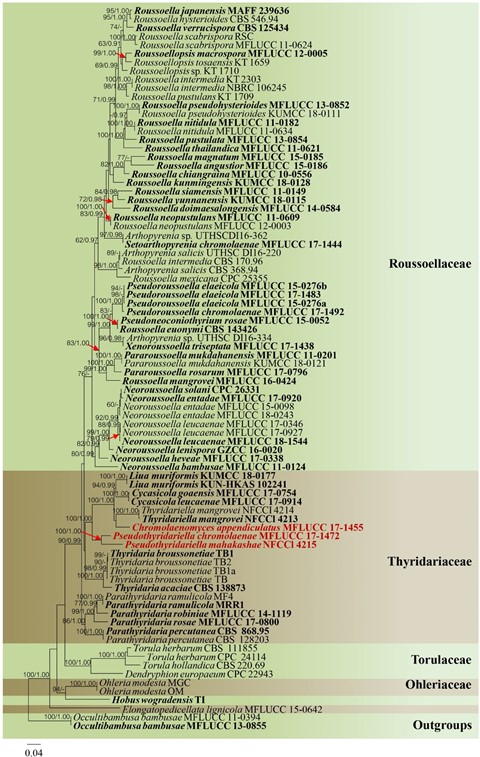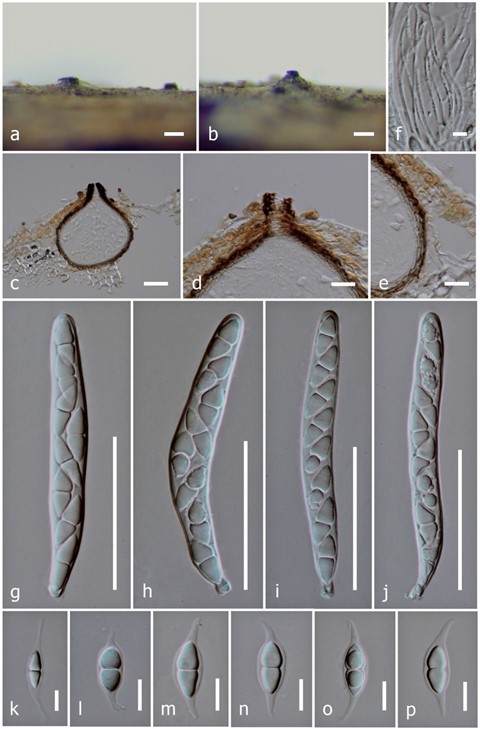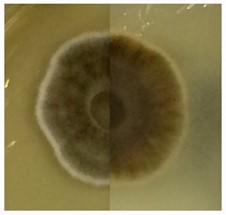Chromolaenomyces appendiculatus Mapook & K.D. Hyde, sp. nov.
MycoBank number: MB 557334; Index Fungorum number: IF 557334; Facesoffungi number: FoF 07825; Fig. 85
Etymology: Referring to ascospores with sheath drawn out to form polar appendages
Holotype: MFLU 20-0307
Saprobic on dead stems of Chromolaena odorata. Sexual morph: Ascomata 175–185 µm high × 140–165 µm diam. ( x̄ = 180 × 155 µm, n = 5), immersed, coriaceous, solitary or scattered, globose to subglobose, light brown to brown. Ostiolar neck protruding. Peridium 7–12(–15) µm wide, 2–3 layers, pale brown to dark brown cells of textura angularis. Hamathecium comprising 0.5–1.5 µm wide, cylindrical to filiform, septate, branching pseudoparaphyses. Asci (75–)85–105 × 10–14 µm (x̄ = 95 × 12 µm, n = 10), 8-spored, bitunicate, fissitunicate, cylindrical, straight or slightly curved, apically rounded, with a short pedicel. Ascospores 15–20.5 × 6–7.5 µm ( x̄ = 17.5 × 7 µm, n = 20), uni-seriate, irregular arrangement, hyaline, oval to broadly fusiform, uni-septate, constricted at the septum, smooth, with a narrow sheath; sheath drawn out to form polar appendages (4.5–)6.5–12(–16) µm long × 2–3.5 µm wide (x̄= 9 × 2.5 µm, n = 30), from both ends of the ascospores, straight or slightly curved. Asexual morph: Undetermined.
Culture characteristics: Ascospores germinating on MEA within 48 h. at room temperature, germ tubes produced from both ends of the ascospores. Colonies on MEA circular to irregular, mycelium slightly raised, entire, cultures olivaceous-grey at the surface with white margin and olivaceous-brown at the center in reverse, white to yellow- white at the margin (Fig. 86a).
Pre-screening for antimicrobial activity: Chromolaenomyces appendiculatus (MFLUCC 17-1455) showed antimicrobial activity against B. subtilis with a 20 mm inhibition zone and against M. plumbeus with a 13 mm inhibition zone, observable as partial inhibition, when compared to the positive control (26 mm and 17 mm, respectively), but no inhibition of E. coli.
Material examined: THAILAND, Lampang Province, Chaehom, on dead stems of Chromolaena odorata, 24 September 2016, A. Mapook (JH1, MFLU 20-0307, holotype); ex-type culture MFLUCC 17-1455.
GenBank numbers: LSU: MT214440, ITS: MT214346, SSU: MT214394, TEF1: MT235770, RPB2: MT235806
Notes: In a BLASTn search of NCBI GenBank, the closest match of the ITS sequences of Chromolaenomyces appendiculatus (MFLUCC 17-1455, ex-holotype) with 83.59% similarity was Roussoella sp. (strain IFM 64548, LC317761). The closest match of the LSU sequence with 99.20% similarity was Cycasicola goaensis (strain MFLU 17-0581, NG_059057). The closest match of the SSU sequence with 92.89% similarity was Parathyridaria percutanea (strain CBS 868.95, NG_062999). The closest match of the TEF1 sequence with 96.86% similarity was Cycasicola goaensis (strain MFLUCC 17-0754, MG829198), while the closest match of the RPB2 sequence with 87.21% similarity was Cycasicola leucaenae (strain MFLUCC 17-0914, MK434900). In the present phylogenetic analysis, C. appendiculatus (MFLUCC 17-1455) is closely related to Thyridariella mangrovei (Fig. 84). However, morphological characteristics of both strains are distinct.

Fig. 84 Phylogram generated from maximum likelihood analysis based on combined dataset of LSU, ITS, TEF1, RPB2 and SSU sequence data. Eighty- four strains are included in the combined sequence analysis, which comprise 4416 characters with gaps. Tree topology of the ML analysis was similar to the BYPP. The best scoring RAxML tree with a final likelihood value of − 35074.673502 is presented. The matrix had 1690 distinct alignment pat- terns, with 39.45% of undetermined characters or gaps. Estimated base frequencies were as follows: A = 0.246392, C = 0.254324, G = 0.268438,T = 0.230846; substitution rates: AC = 1.657341, AG = 4.989387,AT = 2.205689, CG = 1.285998, CT = 10.615734, GT = 1.000000; gamma distribution shape parameter α = 0.486933. Bootstrap sup- port values for ML equal to or greater than 60% and BYPP equal to or greater than 0.90 are given above or below the nodes. Newly generated sequences and new combination are in dark red bold and type species are in bold. Occultibambusa bambusae (MFLUCC 11-0394) and O. bambusae (MFLUCC 13-0855) are used as outgroup taxa

Fig. 85 Chromolaenomyces appendiculatus (holotype) a, b Appearance of immersed ascomata on substrate. c Section through ascoma. d Ostiole. e Peridium. f Pseudoparaphyses. g–j Asci. k–p Ascospores. Scale bars: a, b = 100 µm, c, g–j = 50 µm, d, e = 20 µm, k–p = 10 µm, f = 5 µm

Fig. 86 Culture characteristic on MEA: Chromolaenomyces appendiculatus (MFLUCC 17-1455)
